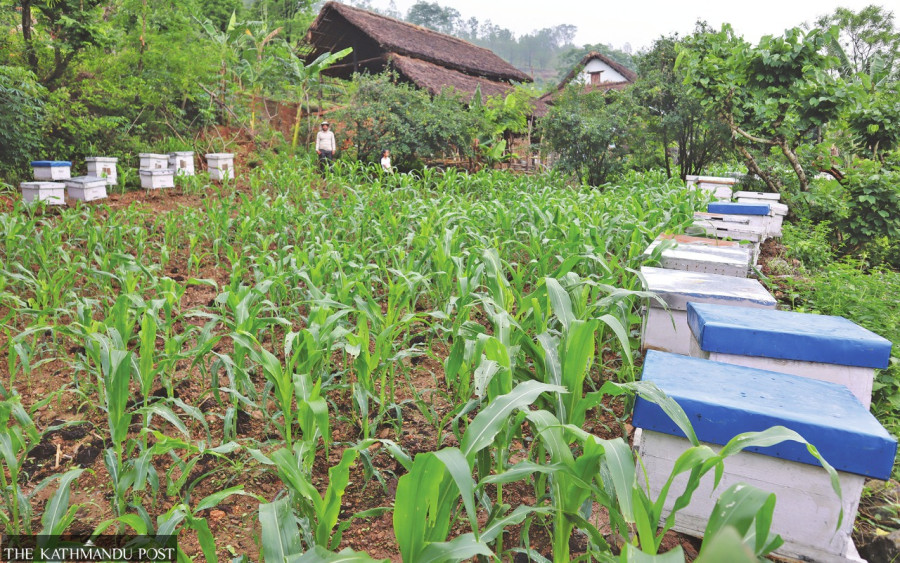Money
Hard times for small businesses amid economic turmoil
High production and fuel costs have made life difficult for small enterprises which create many jobs, experts say.
Krishana Prasain
Handmade paper maker Kiran Kumar Dangol has seen his income dip by 10-15 percent for the first time in his 18 years in the business due to higher costs and falling demand.
“Shipping charges have soared by more than 70 percent, the cost of production has doubled, and productivity has dropped since the pandemic,” said Dangol, owner of Lotus Paper Craft.
The decline in productivity and increased cost of production have made Nepali goods less competitive in the international market, he said.
Dangol says the Russia-Ukraine war has been bad for his business because he ships most of his products overseas. “We use local raw materials to make Nepali handmade paper, but the price has doubled with fuel costs rising continuously,” he said.
Businesses like the one Dangol owns fall under the umbrella of Micro-, Small- and Medium-Sized Enterprises (MSMEs).
June 27 is observed as Micro-, Small and Medium-sized Enterprises (MSMEs) Day, and it will hopefully shed light on the plight of domestic MSMEs like Dangol's paper factory which are going through hard times with the country in the midst of an economic crisis, insiders said.
The United Nations General Assembly has designated June 27 as Micro-, Small and Medium-sized Enterprises Day to raise awareness about the tremendous contributions made by these firms towards the achievement of the Sustainable Development Goals.
MSMEs account for 90 percent of businesses, 60 to 70 percent of employment and 50 percent of gross domestic products worldwide.
MSME Day 2022 focuses on how purpose-driven micro-, small- and medium-sized enterprises and social entrepreneurship are at the centre of contributing to inclusive growth, combating inequalities and building back better and stronger, especially during challenging times.
“Micro, small and cottage industries are on the verge of collapse due to increased raw material prices, high interest rates and lack of access to bank loans,” said DB Basnet, chairperson of the Cottage and Small Scale Industry Committee of the Federation of Nepalese Chambers of Commerce and Industry.
“It has become difficult for entrepreneurs to survive because of the high cost of fuel. There is no specific data, but almost 80 percent of micro, small and cottage industries are close to collapse,” Basnet said.
"Output is down, and it is not easy to get raw materials. The domestic market has also shrunk due to rising inflation, and exports have slowed as a result of high shipping costs," Basnet said.
According to Nepal Rastra Bank, 9,486 micro, cottage and small enterprises had borrowed a combined Rs13.15 billion as of mid-May this fiscal year under the Refinance Procedure 2020.
The central bank said 35,554 micro, cottage and small enterprises took loans totalling Rs35.38 billion in the last fiscal year 2020-21.
Covid-19-affected tourism, cottage, small and medium industries received business continuity loans under the Business Continuity Loan Procedure 2020 to pay staff salaries.
Under this provision, loans amounting to Rs1.13 billion had been approved as of mid-May 2022.
"Financial burdens are being heaped on small enterprises when the sector should be recovering after the Covid-19 pandemic," said Umesh Prasad Singh, president of the Federation of Nepalese Cottage and Small Scale Industries.
“The financial situation of micro, small and cottage industries has weakened, and many entrepreneurs are unable to repay bank loans,” Singh said.
“Micro, small and cottage entrepreneurs are being warned to repay their loans or face foreclosure. Such actions have discouraged many entrepreneurs from doing business. Rising interest hurts the sector where each firm provides jobs to five to 10 people,” he said.
A report entitled Small and Medium-Sized Enterprise Monitor published by the Asian Development Bank in December 2021 says 33.1 percent of MSMEs are using inheritance wealth or ancestral properties while 25.8 percent are using income and savings for initial financing for their business.
About 85 percent of workers in Nepal are informal. The majority of MSMEs are engaged in services and operate in rural areas in the region; only a few cater to international markets, although their impact on exports varies by country.
Access to bank credit remains limited for MSMEs with just 16 percent of them going to banks and financial institutions.
"The situation is different in our southern neighbour," Singh said. "India provides Rs2 million in seed money to micro, small and cottage enterprises with a loan payback time of five years without any interest, which encourages entrepreneurs. The government should provide loans at single-digit interest and special loans to women working in small and cottage industries," he said.
The Micro, Small and Medium-sized Enterprises’ Access to Finance in Nepal report, released by the United Nations Economic and Social Commission for Asia and the Pacific in 2020, says MSMEs contribute 22 percent of Nepal's GDP.
As per the Central Bureau of Statistics, almost half of all business establishments are unregistered, and more than 90 percent of workers working in MSMEs with fewer than 10 workers have informal employee relationships.
The National Economic Census 2018 shows there were 923,356 establishments operating in Nepal, around half of them registered. The MSME sector—which includes 69.3 percent micro enterprises, 25.2 percent small enterprises, and 5.5 percent medium-sized enterprises—employs 2.74 million people.
To boost Nepal’s development, the importance of businesses as primary contributors of growth cannot be overstated. For businesses to reach their full potential and contribute to overall national economic growth, it is fundamental to ensure an enabling environment for them to prosper, experts say.
It is particularly important to facilitate the development of institutions that provide affordable and suitable financial services and products to MSMEs, they said.




 7.12°C Kathmandu
7.12°C Kathmandu













%20(1).jpg&w=300&height=200)
